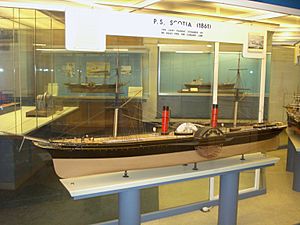RMS Scotia facts for kids

A model of Cunard's Scotia at the Science Museum in London
|
|
Quick facts for kids History |
|
|---|---|
| Name | Scotia |
| Namesake | Scotia |
| Owner | Cunard Line |
| Route | Atlantic crossing. |
| Builder | Robert Napier and Sons, Glasgow |
| Launched | 25 June 1861 |
| Maiden voyage | 10 May 1862 |
| Refit | As a cable layer, 1879 |
| Fate | Lost off Guam, 1904 |
| General characteristics | |
| Type | Passenger liner |
| Tonnage | 3,871 GRT |
| Length | 400 ft (120 m) |
| Beam | 47 ft (14 m) |
| Installed power | 1 x twin-cylinder, 4,000 hp (3,000 kW) side-lever engine |
| Sail plan | 2 masts |
The Scotia was a famous British passenger liner that sailed for the Cunard Line. In 1863, she won the Blue Riband award for being the fastest ship to cross the Atlantic Ocean from west to east. Scotia was special because she was the very last large ocean-going ship to use paddle wheels for power. Even in 1874, she was still one of Cunard's fastest ships. After being retired in 1876, Scotia was changed into a cable layer in 1879. She worked for 25 more years, helping to lay underwater communication cables. Sadly, she was wrecked near Guam in March 1904.
Contents
Building a Giant Ship
The Scotia was built by Robert Napier and Sons in Glasgow. She was designed to be a very large and strong ship. At the time, she was the second largest ship in the world, only smaller than the famous Great Eastern.
The ship was built with seven special watertight sections. These sections were like separate rooms that could be sealed off. This design helped make the ship safer if it hit something or had a leak. It meant that if one part of the ship filled with water, the other parts would stay dry.
Scotia could carry 273 first-class passengers and 50 second-class passengers. She did not have space for steerage passengers, who usually traveled in less comfortable areas.
Why Paddle Wheels?
When Scotia was being designed, there was a big discussion about how she should be powered. Some people thought the ship should use a new type of propeller called a "screw propeller," which was becoming popular. However, Samuel Cunard, the head of the Cunard Line, insisted that Scotia should use traditional paddle wheels.
Paddle wheels are large wheels on the sides of the ship that push water to make the ship move. Even though screw propellers were proving to be better, Cunard wanted to stick with what he knew for his main ship. To test the new technology, Cunard also ordered another ship called China, which used screw propellers.
Scotia had a powerful two-cylinder steam engine that made 4,000 horsepower. This engine was very strong, but it used a lot of coal – about 164 tons every day!
Life at Sea: Scotia's Journeys
The Scotia started her first journey on May 10, 1862. She and the China took over the important New York express route, which was the fastest way to travel between Europe and America.
Winning the Blue Riband
In July 1863, Scotia achieved something amazing: she won the Blue Riband! This award was given to the ship that made the fastest trip across the Atlantic Ocean. Scotia traveled from Queenstown (in Ireland) to New York at a speed of 14.46 knots. This beat the previous record set by another ship called Persia.
Scotia held onto the Blue Riband for a long time, until 1872. Many people consider Scotia to be one of the best ships of her time, especially before the Oceanic was built.
A New Job: Laying Cables
Even though Scotia was fast and comfortable, she wasn't always the most profitable ship. Her sister ship, China, used much less coal and could carry more cargo, even though she was a little slower. Because of this, Cunard started ordering more ships that used screw propellers.
Scotia was the last large paddle wheel ship on the Atlantic Ocean. In 1876, she was finally taken out of service and put up for sale.
Three years later, in 1879, Scotia got a completely new job! She was changed into a cable layer. This meant her paddle wheels were removed, and she was fitted with two screw propellers. She was also made bigger to carry long, heavy underwater cables. These cables were used to send messages across the ocean.
In 1896, Scotia had an accident near Plymouth, England. An explosion damaged the front part of the ship. But because she was built so strongly, she didn't sink. She was repaired and continued her work.
The Final Voyage
In 1902, Scotia was sold to a new company called the Commercial Pacific Cable Company. She continued her work laying cables.
On March 11, 1904, Scotia was approaching the island of Guam to deliver more cable. As she was entering Apra Harbor, she went off course and hit a nearby reef. The weather got worse, and the ship broke into two pieces and sank.
Today, the wreck of the Scotia is a popular spot for divers to explore underwater.
Scotia in Books and Stories
The Scotia is so famous that she even appears in books!
In the classic adventure novel Twenty Thousand Leagues under the Sea by Jules Verne, the submarine Nautilus accidentally bumps into the Scotia on April 13, 1867. The book describes a neat hole appearing in the ship. But thanks to her strong, watertight sections, the Scotia safely made it back to Liverpool.
The SS Scotia also appears in the second book of the Sherlock Holmes: The Legend Begins series. In this story, Sherlock Holmes and his friends travel on the ship.

